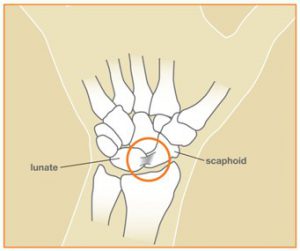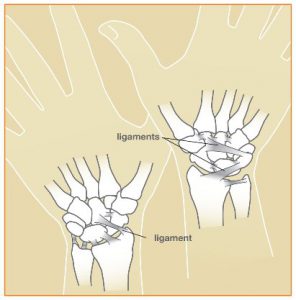Sprain
A sprain is an injury to a ligament, the connective tissue that holds bones together at a joint. In the wrist, the most frequently injured ligament is the scapho-lunate ligament, which connects the scaphoid and lunate bones. Sprains can range from minor stretches to complete ligament tears. Another structure commonly affected is the triangular fibrocartilage complex (TFCC).
Causes
Wrist sprains typically occur when a person falls and lands on an outstretched hand, causing the wrist to bend backward and stress the ligaments.
Signs and symptoms
After a sprain, the wrist usually swells and bruises, and movement becomes painful. The injury often results in limited mobility and discomfort during everyday activities.
Treatment
Diagnosis
The doctor will start with a physical examination to pinpoint the area of pain and assess wrist movement. X-rays are used to rule out fractures or dislocations, and sometimes an MRI is ordered for a detailed view of the ligament damage.
Acute treatment
Initial treatment for a wrist sprain may involve immobilizing the wrist with a splint or cast. In some cases, surgery is necessary. Surgical options include arthroscopic procedures—performed through small incisions with a camera and specialized instruments—or open surgery to repair the damaged ligament using pins, screws, or other devices. Postoperative care typically involves immobilization for several weeks.
Chronic injuries
For injuries that have persisted for months or years, treatment depends on the extent of damage. If there is minimal cartilage damage, ligament reconstruction may be considered. However, if moderate to severe cartilage damage (arthritis) is present, symptoms such as pain, stiffness, and swelling may continue. Initially, chronic injuries may be managed with splinting, non-steroidal anti-inflammatory drugs (NSAIDs), and cortisone injections, with surgery as a later option. Surgical approaches might include partial wrist fusion, proximal row carpectomy (removal of arthritic bones), wrist replacement, or complete wrist fusion.
Associated injuries
Occasionally, fractures occur along with a sprain, requiring additional procedures to repair the bone with metal pins, screws, or plates. Cartilage damage may also accompany the sprain, even if it isn’t visible on x-rays.
Future treatments
Ongoing research aims to develop better treatments for wrist sprains, focusing on stronger and more precise ligament reconstruction techniques. These innovations may use tissues from the local area or grafts from other parts of the hand or foot.
Prognosis
Even with optimal treatment, some individuals may experience long-term pain, stiffness, and swelling. Due to the wrist’s complex arrangement of bones, cartilage, and ligaments, injuries can disrupt its finely tuned balance and lead to lasting functional issues.
Key Takeaways


